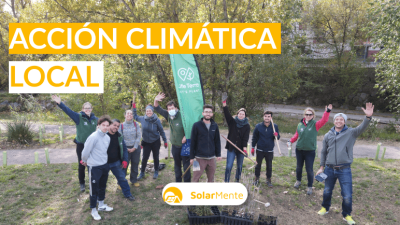Many of our daily activities such as taking the car, keeping the TV on for hours on end, running the washing machine or letting the water run unchecked, generate a significant increase in our carbon footprint.
The growth of this indicator is increasingly noticeable, accumulating a greater number of polluting emissions in the atmosphere and accelerating climate change.
Despite the fact that pollution has decreased since 2008, Spanish households will account for 23% of total greenhouse gas emissions in 2021, according to data from the INE. This is a high figure that we must emphasise for the sustainability of the planet.
However, concern about climate change has been on the rise. If you do not know how to tackle the problem and help with actions that generate a positive impact on the environment, in this article we explain how to reduce your carbon footprint.
To do so, we will discuss the following points:
-
What does the concept of carbon footprint mean?
-
Why it is important to reduce your carbon footprint
-
8 tips to become more sustainable and reduce your carbon footprint
What is a carbon footprint?
The carbon footprint indicates the total volume of greenhouse gases in the atmosphere.
Certain perceived gases, such as carbon dioxide or methane, contribute to global warming, resulting in an increase in the average temperature of the planet.
The presence of these gases is generated by our daily activities, especially transport, electricity and food.
Since 1961, the carbon footprint has grown like crazy, multiplying by 11 times until today, according to data from Global Footprint Network.
Without going any further, transport accounts for 27% of total emissions in Spain, making it the undisputed leader in the list. Other sectors such as industry (20.8%) and electricity generation (11.8%) also play a leading role in this respect.
Large companies have high percentages of atmospheric emissions that require immediate measures to curb their advance as much as possible.
However, beyond the global decisions still to be taken, it is essential to take action in our consumption habits to reduce our personal carbon footprint.
Why it is important to reduce your carbon footprint
The carbon footprint has a negative impact on the Earth and accelerates climate change.
As a result, over the years, we are experiencing warmer days and more intense and longer lasting heat waves.
You’ve noticed it too, haven’t you?
In addition, other extreme weather phenomena become more frequent: snowstorms, hurricanes, droughts and so on.
Moreover, if we take global sea level data, there has been an increase of 4.5 mm from 2013 to 2021, a new record high.
Moreover, we must not forget the population growth forecasts for the coming decades. According to the United Nations, we could reach 9.7 billion people by 2050.
This means that pollution could experience a further significant increase if we do not work on it steadily, focusing on measures to slow down global warming such as the use of clean and renewable energies.
The benefits of reducing the carbon footprint are:
-
Holding back the increase in the Earth’s average temperature.
-
Protecting plant and animal life. Slowing climate change will help prevent damage to plant and animal habitats.
-
Increased economic savings. Extreme weather causes damage to the ecosystem and society, increasing environmental and personal repair costs.
-
Healthier for the entire population. By reducing the carbon footprint, levels of CO2 and other polluting gases also decrease.
8 tips to reduce your personal carbon footprint
Reducing our carbon footprint requires responsibility on our part. Improving consumption habits will result in less pollution from industries as demand for certain products or services is reduced.
This is why our actions have an important weight in the decision making process of companies.
But how can we reduce our carbon footprint, and do we need to make drastic changes to see results?
Not at all. You can start with any of the following 8 tips. Every small gesture is a point in favour of the environment:
1. Switch to clean energies
Global energy policies were created with one goal in mind: to reduce fossil fuel consumption and encourage the use of clean, renewable energy.
For example, solar energy is an inexhaustible and 100% clean source of energy that reduces greenhouse gas emissions, since the manufacture of solar panels has a minimal impact on pollution.
It has become one of the most economical energies and the government and the autonomous communities are offering aid for photovoltaic installations.
2. Use less polluting means of transport
On average, a car produces 4.6 metric tons of CO2 per year by burning fossil fuels.
So transport has a significant influence on pollution, especially if we are talking about cars that use diesel or petrol.
So how can we reduce the carbon footprint of transport?
You can use public transport. If you need a car, take advantage of car-sharing services.
Other more sustainable and cleaner means of transport are cycling or walking. If the distances are short, these are perfect alternatives to take. You can even do a combination of both.
Finally, choosing an electric vehicle is another way to go for sustainability. If you are curious, you can read this article about how electric car chargers work.
3. Reduce the amount of waste and recycle it.
The amount of waste generated by food waste and food residues exceeds 2 million tonnes per year and, although it may seem like a small figure, it is claimed to be three times more than the emissions emitted by air travel.
Therefore, separate and recycle waste according to the regulations established in the geographical area where you live to give these items a second life.
Similarly, we can get ahead of the problem by taking preventative action to reduce and reuse products as much as possible to avoid a high volume of waste.
A clear example is electrical appliances such as a television or a mobile phone. Instead of throwing them away at the drop of a hat, repair them with the aim of extending their useful life.
4. Change your electricity consumption habits
Small variations in the use of energy cause a significant reduction in the emission of polluting gases into the atmosphere.
How to reduce your carbon footprint at home is simpler than it seems.
Here are a few tips:
-
Don’t leave chargers plugged in if your electrical appliances (mobile phone, computer, etc.) are fully charged.
-
Opt for low-consumption appliances that allow you to save energy and reduce your electricity bill at the same time.
-
Use energy-saving light bulbs.
-
Dry your clothes in the open air.
5. Buy the necessary clothes
The fashion industry produces more than 8% of polluting gases and 85% of garments end up in landfills with hardly any use or are incinerated, according to UN data.
These products decompose, emitting a greenhouse gas known as methane, which has a negative impact on the planet and our health.
Before buying any item of clothing, think about whether you really need it. You also have other interesting options: go to second-hand clothes shops or ecological companies that use recycled materials.
6. Use cloth bags at the supermarket
When you go shopping, don’t forget to always carry a cloth bag with you to avoid using plastic. Their manufacture increases your carbon footprint.
It is one of the biggest enemies of the environment and with this small gesture we help to reduce its harmful effect.
7. Consume local products
Also make responsible consumption. Buy only the food you need, and if it is local, all the better. Opt for local and seasonal products whenever you can, as well as being harvested in a sustainable way.
In this way, if the produce comes from places close to where you live, less transport is needed to deliver it to the end consumer.
Think about it.
Imported products require long-distance journeys where more transport is needed. In short, this is a further increase in CO2.
8. Control your water consumption
It is important to reduce water consumption and rationalise it in order to make ecosystems healthier. This will allow vegetation to grow to absorb carbon dioxide.
How can I reduce my carbon footprint in this case?
Consume water responsibly using the following tips:
-
Shorter showers
-
Turn off the taps while brushing your teeth
-
Use the washing machine to its full capacity to use less water.
Frequently asked questions about reducing your carbon footprint
What are CO2 emissions?
Carbon dioxide (CO2) is the main greenhouse gas emitted into the atmosphere as a result of human activities.
How to drive decarbonisation?
According to the Council of Ministers, at the proposal of the Ministry for Ecological Transition and the Demographic Challenge (MITECO), “it is urgent to promote the deployment of clean energies, which will allow 74% of electricity in Spain to be renewable by 2030 and reach 100% by 2050, thus contributing to achieving the objective of climate neutrality that the country has set itself in line with the Paris Agreement and the commitments of the European Union”.
What does decarbonising energy mean?
To address the climate emergency and ensure the reduction of greenhouse gases, renewable energies undoubtedly have advantages. And solar energy, especially, has great potential to lead the decarbonisation of energy in Spain.
The use of a 100% natural and inexhaustible primary energy source such as photovoltaic solar energy does not produce CO2 emissions or other harmful components in the atmosphere.
It contributes to the use of self-consumption of electricity that makes you independent from conventional energy companies. This reduces the need to support extractive industries, while avoiding the use of fossil fuels. At the same time, it is a source of sustainable jobs.
How to redirect the energy model towards decarbonisation?
Changing course towards a more sustainable energy model and embarking on the path towards decarbonisation is an absolute necessity.
According to data from the European Commission’s Climate Action department, the concentration of CO2 in the atmosphere is currently 40% higher than the levels recorded at the start of industrialisation.
Several strategies have been implemented by countries and organisations to combat climate change:
Agenda 2030, which aims to reduce emissions by at least 55% by 2030 compared to 1990 levels.
The Long-Term Decarbonisation Strategy, which will reduce greenhouse gas emissions by 90% by 2050 compared to 1990.
What does it mean to decarbonise the energy model?
According to the Intergovernmental Panel on Climate Change (IPCC), decarbonisation refers to the process by which countries, individuals or other entities aim to eliminate the consumption of fossil fuels.
What is the environmental impact of having solar energy in my home?
With our solar kits in your home, installing an average of 12 solar panels would be the equivalent of planting 4 trees and saving the pollution of 2.05 tonnes of CO2 (carbon dioxide) that you would not be emitting into the atmosphere.
How to reduce your carbon footprint with small changes in your daily routine
To reduce our carbon footprint we need to make changes from a variety of perspectives.
In addition to the governmental measures that are being implemented globally, we need to change some habits in our daily activities.
You can start with the tips mentioned in this article: use more sustainable means of transport, recycle, reduce waste or opt for the use of clean energy in the home, among many other possibilities.
One of the alternatives that has been gaining prominence in recent years is solar energy, which is capable of slowing down climate change thanks to its reduced impact on the environment.
For this reason, at SolarMente we want you to enjoy all the benefits of self-consumption without worrying about the volatility of electricity prices, knowing that the energy generated will always be clean.















